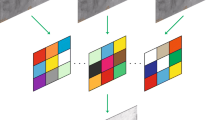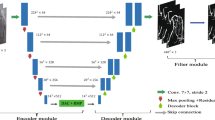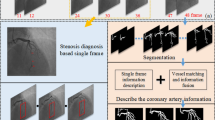Abstract
This paper addresses the research focuses on coronary artery disease; it is one of the major heart diseases affecting the people all around the world in the recent era. This heart disease is primarily diagnosed using a medical test called angiogram test. During the angiogram procedure the cardiologist often physically selects the frame from the angiogram video to diagnose the coronary artery disease. Due to the waning and waxing changeover in the angiogram video, it’s hard for the cardiologist to identify the artery structure from the frame. So, finding the keyframe which has a complete artery structure is difficult for the cardiologist. To help the cardiologist a method is proposed, to detect the keyframe which has segmented artery from the angiogram video.
Access this chapter
Tax calculation will be finalised at checkout
Purchases are for personal use only
Similar content being viewed by others
References
Zifan A, Liatsis P ((2016)) Patient-specific computational models of coronary arteries using monoplane X-ray angiograms. Comput Math Methods Med
Badila E, Calmac L, Zamfir D, Penes D, Weiss E, Bataila V (2017) The cardiovascular system and the coronary circulation. In: Itu L, Sharma P, Suciu C (eds) Patient- specific Hemodynamic Computations: Application to Personalized Diagnosis of Cardiovascular Pathologies 2017. Springer, Cham, pp 13–59
Jiang** S, Zhe Z, Wei W, Yunhu S, Jie H, Hongyue W, Hong Z, Shengshou H (2013) Assessment of coronary artery stenosis by coronary angiography: a head-to-head comparison with pathological coronary artery anatomy. Circ Cardiovasc Intervent 6:262–268
Syeda-Mahmood T, Beymer D, Wang F, Mahmood A, Lundstrom RJ, Shafee N, Holve T (2010) Automatic selection of keyframes from angiogram videos. In: 2010 20th international conference on pattern recognition. IEEE, pp 4008–4011
Tsai YC, Lee HJ, Chen MYC (2015) Automatic segmentation of vessels from angiogram sequences using adaptive feature transformation. Comput Biol Med 62:239–253
Cervantes-Sanchez F, Cruz-Aceves I, Hernandez-Aguirre A, Aviña-Cervantes JG, Solorio-Meza S, Ornelas-Rodriguez M, Torres-Cisneros M (2016) Segmentation of coronary angiograms using gabor filters and boltzmann univariate marginal distribution algorithm. Comput Intell Neurosci 2016
M'hiri F, Duong L, Desrosiers C, Leye M, Miró J, Cheriet M (2016) A graph-based approach for spatio-temporal segmentation of coronary arteries in X-ray angiographic sequences. Comput Biol Med 70:45–58
Song S, Du C, Chen Y, Ai D, Song H, Huang Y, Yang J (2019) Inter/intra-frame constrained vascular segmentation in X-ray angiographic image sequence. BMC Med Inf Decis Mak 19:1–11
**a S, Zhu H, Liu X, Gong M, Huang X, Xu L, Guo J (2019) Vessel segmentation of X-ray coronary angiographic image sequence. IEEE Trans Biomed Eng 67:1338–1348
Nachamai M, Paulose J, Marandi S (2018) A Comparative analysis of the efficiency of video reader object for frame extraction in MATLAB. J Multimedia Process Technol 9:16–21
Barnes GT, Lauro K (1989) Image processing in digital radiography: basic concepts and applications. J Digit Imaging 2:132–146
Norouzi A, Rahim MSM, Altameem A, Saba T, Rad AE, Rehman A, Uddin M (2014) Medical image segmentation methods, algorithms, and applications. IETE Tech Rev 31:199–213
Cui H, **a Y, Zhang Y (2019) 2D and 3D vascular structures enhancement via improved vesselness filter and vessel enhancing diffusion. IEEE Access 7:123969–123980
Canero C, Radeva P (2003) Vesselness enhancement diffusion. Pattern Recogn Lett 24:3141–3151
Frangi AF, Niessen WJ, Vincken KL, Viergever MA (1998) Multiscale vessel enhancement filtering. In: International conference on medical image computing and computer-assisted intervention. Springer, Heidelberg, pp 130–137
Jerman T, Pernuš F, Likar B, Špiclin Ž (2015) Beyond frangi: an improved multiscale vesselness filter. In: Medical Imaging 2015: Image Processing. vol 9413. SPIE, pp 623–633
Kerkeni A, Benabdallah A, Manzanera A, Bedoui MH (2016) A coronary artery segmentation method based on multiscale analysis and region growing. Comput Med Imaging Graph 48:49–61
Zhang F, Zhang X, Liu X, Cao K, Du H, Cui Y (2014) Blood vessel enhancement for DSA images based on adaptive multi-scale filtering. Optik 125:2383–2388
Li Z, Zhang Y, Liu G, Shao H, Li W, Tang X (2015) A robust coronary artery identification and centerline extraction method in angiographies. Biomed Signal Process Control 16:1–8
Bai X, Zhou F (2013) A unified form of multi-scale top-hat transform based algorithms for image processing. Optik 124:1614–1619
Singh RP, Agarwal P (2013) Extraction of region of interest through e-learning videos with matlab. Int J Comput Appl 68:38–40
Author information
Authors and Affiliations
Corresponding author
Editor information
Editors and Affiliations
Rights and permissions
Copyright information
© 2023 The Author(s), under exclusive license to Springer Nature Singapore Pte Ltd.
About this paper
Cite this paper
Kavipriya, K., Hiremath, M. (2023). A Novel Approach for Segmenting Coronary Artery from Angiogram Videos. In: Joby, P.P., Balas, V.E., Palanisamy, R. (eds) IoT Based Control Networks and Intelligent Systems. Lecture Notes in Networks and Systems, vol 528. Springer, Singapore. https://doi.org/10.1007/978-981-19-5845-8_14
Download citation
DOI: https://doi.org/10.1007/978-981-19-5845-8_14
Published:
Publisher Name: Springer, Singapore
Print ISBN: 978-981-19-5844-1
Online ISBN: 978-981-19-5845-8
eBook Packages: EngineeringEngineering (R0)




